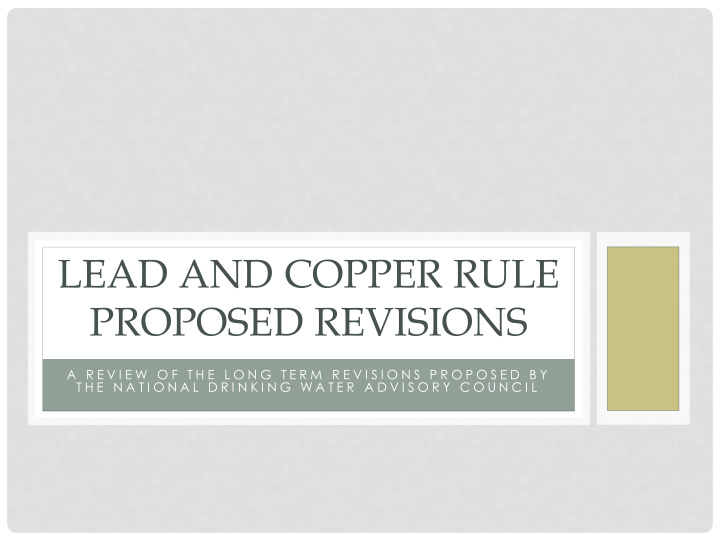



LEAD AND COPPER RULE PROPOSED REVISIONS A R E V I E W O F T H E L O N G T E R M R E V I S I O N S P R O P O S E D B Y T H E N A T I O N A L D R I N K I N G W A T E R A D V I S O R Y C O U N C I L
THERE IS NO SAFE LEVEL OF LEAD 0.015 MG/L IS BASED ON FEASIBILITY
HISTORY OF LEAD REGULATION
BACKGROUND • LCR is a treatment technique rule • Requires actions to be taken to minimize lead and copper in drinking water • Small/medium systems (Pop. <50,000) must take specific actions if the action level is exceeded (Lead 0.015mg/L, Copper 1.3mg/L) • Large systems (Pop. >50,000) must minimize corrosivity of the water prior to an exceedance • Newly serving 50,000 must also meet this requirement
LCR PROPOSED CHANGES • Lead sampling protocols • Increased corrosion control treatment • Lead material removal • Household action level • Separate copper rule
LEAD RULE PROPOSED CHANGES Source: 2015 LCRWG Final Report
SAMPLING • Problems: • Finding locations and participants can be difficult • Inconsistent sampling from customers • Results vary based on lead source in home • Sampling infrequent and in relatively few homes • Proposed changes • Customer initiated tap sampling through targeted outreach • Increased focus on maintaining water quality conditions • New tiering criteria
CORROSION CONTROL • Problems: • Treatment interactions • Difficulty maintaining throughout distribution • Improved science without guidance • Proposed changes: • System specific water quality parameters • New guidance provided based on advancing science • Increased WQP monitoring • Any treatment or source change requires re-evaluation of corrosion control
LEAD SERVICE LINE REPLACEMENT • Problems: • Partial replacement • Only focuses on LSL while goosenecks and pigtails may be a similar risk • Proposed changes: • Remove all lead service lines and lead components over 30 year period • Shared responsibility
HOUSEHOLD ACTION LEVEL • Problems: • Consumer notice is insufficient • Potential violation of section 1431 due to “imminent and substantial endangerment to the health of persons” • Proposed changes: • Set HAL based on CDC recommendations • Notify residents and local health departments
COPPER RULE PROPOSED CHANGES • Problems: • Highest risk sites different than lead • Lack of public education • Proposed changes: • Remove in-home sampling • Monitoring based on water corrosivity to copper • Non-aggressive water • Continue to demonstrate • Aggressive water • Public education requirement • Mitigate risk Source: 2015 LCRWG Final Report
COPPER CORROSION LCRWG defined corrosive conditions – pH and alkalinity LCRWG defined corrosive conditions – PO 4 and alkalinity • Low pH and high alkalinity most corrosive to copper Source: Journal AWWA April 2016 Roth et al.
PREPARATION TIPS Materials Evaluation Address Copper Corrosion Recruit Customers
REMINDERS FOR CURRENT LCR • Highest risk sites • No “pre - flushing” • Aerators on • Wide-mouth bottles and fill as you would a drinking glass • Consumer notice and certification to the State is required • Sample early in the monitoring period
THANK YOU M E G A N L A R S O N I D A H O D E P A R T M E N T O F E N V I R O N M E N T A L Q U A L I T Y M E G A N . L A R S O N @ D E Q . I D A H O . G O V
Recommend
More recommend